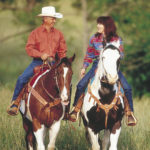Tying Up – What to Watch For: Sudden reluctance or inability to move; excessive sweating; resting heart rate over 60 BPM; resting respiration rate over 30 BPM; Hard, tense hindquarter muscles; swishing tail; horse will show signs of pain, and may try to move away, if pressure is applied to this area (be careful–he may try to kick you).

Tying Up – What’s Happening:
Exercise-related muscle degeneration (the exact cause is unknown), causing severe cramping and pain.
Tying Up – What to do:
- Step 1: Stop and dismount; continuing exercise will cause further muscle damage. Do not attempt to walk your horse out of it.
- Step 2: Administer a dose of xylazine/ butorphanol, to relax your horse and relieve muscle cramping.
- Step 3: Administer a dose of phenylbutazone (bute), to reduce inflammation, and control pain.
- Step 4: Offer your horse water; a dehydrated body can’t eliminate toxic byproducts caused by muscle degeneration.
- Step 5: After all signs of tying up have disappeared, slowly head for home, leading your horse, and stopping every half -hour for a 5- to 10-minute rest. (If you’re on an overnight trip, make camp wherever you are, or as close by as possible, and allow your horse to rest until morning; then slowly head home.) If your horse’s condition fails to improve, send your buddy for veterinary help.
- Step 6: For 1 or 2 days after a tying-up episode, watch your horse’s urine for signs of discoloration. If you notice dark urine–indicating the potential for kidney damage–call your vet.
Tying Up – Risk Factors:
Above-average exertion, especially after a period of rest.
Diet: Some horses tie up when fed large amounts of alfalfa or grain, especially when not accustomed to it. A deficiency in the mineral selenium, which contributes to healthy muscle function, also cal lead to tying up.
Genetics: Some horses have a genetic predisposition to tying up. (This may explain why horses that’ve tied up seem more prone to recurring episodes.)
Tying Up – Preventative Measures:
Consult with your vet to develop a conditioning program prior to an out-of-the-ordinary trail ride.
Don’t increase your horse’s ration prior to a difficult ride in anticipation of his need for additional energy.
Consult with your vet to be sure your horse is getting enough selenium in his daily ration. If you live in a selenium-deficient area, your vet may suggest a blood test to measure your horse’s selenium level.
If your horse is prone to tying up (he’s tied up before, or comes from a bloodline in which it’s a common problem), supplement his daily ration with 500 to 1000 IU of vitamin E, and 10 grams of vitamin C. These vitamins are believed to reduce muscle damage related to tying-up syndrome.
Click here to read more articles on Trail Riding First Aid.
Barb Crabbe, DVM, is a contributing editor at Horse & Rider.?She is an Oregon-based equine practitioner.
This article first appeared in Horse & Rider.





